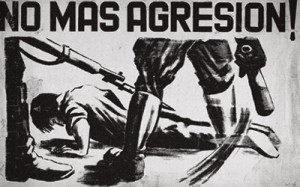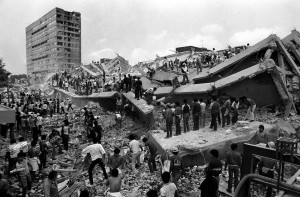
While I was in school, the curriculum was largely centered around the study of social and political movements. Of course, at that age you do not try to make sense of it. Rather, you relate it to what is happening within your country, your neighborhood, and your family, at the time. Even as I related history to the context in which I was situated, there were many nuances. Within my neighborhood and family there was a range of political affiliations: there were democrats, leftists, and even rightists. This demonstrates how independent and self-driven everybody was. Although this individualism could be seen as a positive dynamic, many times these divisions were due to lack of agreement and organization. When I was an adolescent it was difficult for me to distinguish who, or what, was “right” within these movements.
When I was in school, the student movement took off. At the time, the student organizers were largely focused on recruiting students for their movements. The seventeen and eighteen year olds in high school were particularly susceptible to recruitment, because as I mentioned previously, they were not yet able to distinguish from “right” and “wrong”. High school was such a crucial part in developing political consciousness and defining party affiliation because the college and university system in place at the time was closely linked to these movements. I was well aware and alarmed of these divisions – they had their benefits and their consequences.
Although I was a great student who prided himself in learning and analyzing the various perspectives that surrounded me, many times it was difficult for me to define my social and political foundation. This was partly due to my background and how I was raised to be very independent in decision-making, but this was also closely linked to the persuasiveness and persistence that the student organizers exhibited in the recruitment process. In many ways these recruiters would brain wash you. They would emphasize the importance of the movement without being transparent about who it benefited. According to them, the movement was intended to go against the current political system of the time in order to serve the larger interests of the people. However, the movement hardly served these purposes.
At that time, the National Autonomous University of Mexico served as the foundation to Mexican education. I briefly formed part of this university when I was studying to become an industrial engineer. The university was extremely divided by political interests. A student group that aimed to disrupt the political system of the time comprised one of these divisions. However, rather than being involved in demonstrations, this particular group dedicated itself to vandalism, recruiting freshmen, and dividing opposing student groups. Despite priding myself in better judgment, I formed part of this particular group.

When this student group first approached me, they condemned me for my physical strength – I remember being very physically active and sporty during my adolescence. This group also believed that my intelligence would allow me to better navigate through situations in which quick decisions needed to be made. I remember being susceptible to their promises to “help us pass classes” and to “make university matters easier to us”. As I mentioned before, I lacked mentorship and parental guidance. I thought that if I could facilitate my journey through university, I would be demonstrating ownership within my life and education experience. Unfortunately, rather than being involved in political or intellectual fights, many times, the group that I was a part of, was directly involved in physical fights. I recall how manipulative the group leaders were. At one point they even promised us university degrees in exchange for the captivity of various political figures of the time. Once I realized that the corruption and violence they were fighting was projected within their own student movement, I disassociated. Instead of helping me get through school and set a foundation of support, this student group caused even more problems within my life at the time; it was not something I needed.
This era of historical violence continued throughout the 80s. I also lived through the Mexico City Earthquake of 1985. This earthquake caused mass destruction. My family was very fortunate because nobody was injured; however, I cannot say the same about some of the people I knew.

During the time of the earthquake, I was at work in a metallurgic factory; there, I would help distribute and store tools. I worked at that factory, despite low wages, because I wanted to pay for my education. I was working the day shift, when all of a sudden the ground began to shake. The workers began to yell for evacuation. As fast as I could, I got out of the building only to catch a glimpse of the horrors that were occurring. People were screaming and buildings were collapsing. Fear began to run through my mind as I began to think about my family and what could have happened to them. I immediately attempted to call them but all of the phone lines were down. Due to the disaster, it was difficult to get home. My first instinct was to get to a source of public information distribution. I looked for a television and I began to watch the news. The news reporters showed images of the collapsed buildings. I remember watching a report on how hundreds of children died when schools and pediatric hospitals collapsed. It was a nightmare.
I will never forget the damage and the horrors that this earthquake had in my city and in my country. The government attempted to respond to this crisis by passing new legislature for building construction, but at that point it was too late. Natural disasters help reveal how inadequate the government is at handling certain situations. Combined, the student demonstrations and the lack of response to the Earthquake of ’85, showed how weak the Mexican government was at the time.
Following the Earthquake of ’85, there was a sudden devaluation of the peso. Due to how closely education, politics, and economics were at the time, the government and the people suffered collectively. Personally, I believe that the biggest cause for this mishap came from the top of the hierarchy. At the time, Mexican presidents ran for candidacy for personal gain. Nobody was serious about trying to create a better future for the country. Because of these weak reasons for power, the country was left indebted and weak, something that has not changed to this day. There are many stories that attempt to explain what happened at this time. One thing that they all have in common is that they acknowledge the terrible levels of corruption and debt that the Presidents of the time caused. The devaluation of the peso created a very difficult atmosphere for the citizens of the time. More so, it became nearly impossible to find both educational and job opportunities. All of these causes and events were central influences in my decision to immigrate.
NEXT SECTION – Push for Migration: Chaos and Disillusionment